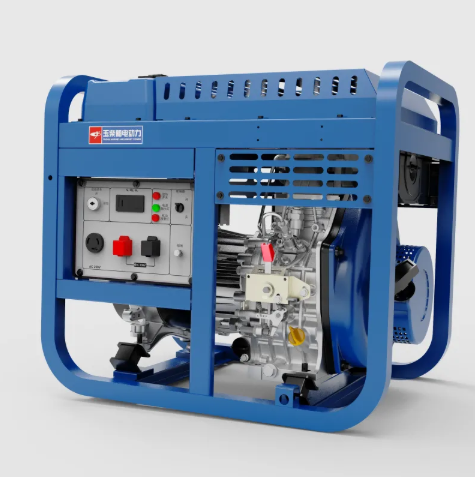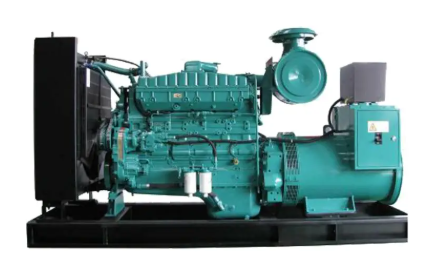Calculating Power Requirements for Industrial Diesel Generators
Determining Total kW Load for Prime and Standby Applications
Getting the total kW load right for industrial diesel generators means knowing what equipment runs on them and how they operate day to day. Start by adding up all the wattages from every device connected to the system. Think about things like pumps, control panels, various machines etc., just write down everything and tally those numbers. Know the difference between prime vs standby generators too. Prime units work nonstop for extended periods, whereas standby models kick in only when there's a blackout situation. The actual runtime and how much power fluctuates matters a lot when picking which type fits best. Don't forget to factor in possible expansion plans either. A factory might grow, new machinery added later could push the load way beyond current capacity, so it pays to plan ahead for these scenarios.
Accounting for 125% Surge Capacity in Generator Sizing
Getting enough surge capacity when sizing generators matters a lot for handling those unexpected spikes in electricity demand. Most experts suggest following what's known as the 125% rule for calculations. Basically, figure out what the maximum load could be when equipment starts up, then multiply that number by 1.25 so the generator isn't caught off guard by peak loads. This becomes especially important for places like data centers or factories where machines kick on all at once and draw massive amounts of power right from the get-go. When generators are sized properly using this approach, operations stay stable without risking overload situations that damage expensive gear and waste money on repairs down the road.
Analyzing Resistive, Reactive, and Non-Linear Load Characteristics
Knowing about the various load types - resistive, reactive, and non-linear - plays a big role when evaluating how well generators perform. Resistive loads are straightforward stuff like old fashioned light bulbs and space heaters that basically turn electrical current straight into warmth. Then there's reactive loads found in things like electric motors and transformers which create magnetic fields during operation and mess with something called the power factor. Non-linear loads come from equipment such as computer systems and uninterruptible power supplies, and they actually warp the electrical waveform causing what's known as harmonic distortion that really throws off generator efficiency over time. Most diesel generators work best when operating at a power factor above 0.85, though this can vary depending on application specifics. When looking at generator options, it makes sense to consider factors like inductive loading characteristics and potential harmonic issues so the chosen unit matches actual site requirements rather than just theoretical specifications.
Selecting Between Standby vs Prime Power Diesel Generators
Backup Power Solutions for Critical Infrastructure
Backup generators are really important for keeping critical systems running when the main power goes down. Places like hospitals, data centers, and telecom hubs rely on them to stay operational during blackouts. When the grid fails, these generators take over instantly so there's no gap in service at all. The rules around this stuff emphasize how little downtime matters. Think about a hospital operating room or emergency services - even one second without power could be dangerous. That's why when businesses choose their backup power options, they need something super reliable with fast startup times. Getting this right means life saving equipment keeps working, servers don't crash, and communication networks stay connected during those unpredictable power failures we all face from time to time.
Continuous Operation Requirements for Remote Facilities
Prime power diesel generators just plain matter for those remote facilities without reliable grid connections. Mining sites and oil rigs need these generators because their operations simply cannot afford interruptions. Get this wrong and companies face serious money problems from equipment shutdowns or burning through extra fuel. The numbers back this up too many businesses have learned the hard way that picking the right generator makes all the difference in cutting down long term costs. Smart companies know better than to cut corners here since generator choice affects everything from daily operations to bottom line profits over time.
Run-Time Considerations for Fuel Efficiency
Standby and prime diesel generators each bring something different to the table when it comes to runtime and how much fuel they burn. Fuel efficiency really matters though, particularly for those prime units that have to keep running nonstop for days on end during outages. Good load management makes all the difference here. Companies that track their generator usage patterns and adjust loads accordingly often see big drops in fuel bills. Some facilities even install smart monitoring systems that automatically tweak settings based on actual demand. These kinds of optimizations help businesses save money without compromising power reliability. The bottom line is straightforward: smarter fuel management translates directly into lower operating costs while still keeping lights on and equipment running smoothly through whatever challenges come along.
Technical Specifications for Industrial Generator Integration
Matching Voltage or Frequency to Plant Switchgear
Getting the generator's voltage and frequency right when connecting to existing plant systems makes all the difference in how well everything works together. When the generator output matches what the plant switchgear expects, power flows smoothly through the system while reducing chances of electrical problems down the line. Standards like IEEE 1547 actually provide pretty good guidance on how generators should connect to grids, which helps keep things stable and avoids those frustrating integration headaches. If there's a mismatch somewhere, plants often end up wasting energy or worse yet, damaging expensive equipment. That's why taking time to get these settings correct from day one matters so much for making sure generators perform at their best and keep power flowing without interruptions during operation.

Evaluating Motor Starting Methods: DOL vs Star-Delta vs VFD
Knowing which motor starting method works best matters when picking options for generator setups. Take Direct-On-Line (DOL) for instance. It's simple and doesn't break the bank, but watch out for those big startup currents that can cause problems. That's why DOL usually gets used only on smaller motors where the extra current isn't such a concern. Star-Delta starts are another common approach, especially for bigger motors since they cut down on that initial current surge. However, these systems tend to lose some efficiency after running for a while. Then there are Variable Frequency Drives (VFDs), which give operators much better control over how fast the motor ramps up and runs at different speeds. This makes them great for applications where workload changes throughout the day. What actually ends up getting chosen often comes down to what exactly the equipment needs to do and how important certain performance factors are in each particular situation.
Three-Phase Power Compatibility Testing
Checking if a generator works properly with three-phase power systems matters a lot when running generators in various settings. When doing compatibility testing, technicians basically check whether what comes out of the generator actually fits what the building needs electrically. This makes sure electricity flows safely through the system without causing problems. Skipping these tests puts everything at risk. We've seen situations where generators caused massive power spikes that fried equipment or shut down entire operations for days. Real world examples show how companies suffer big losses when they rush installation without proper checks first. A few hours spent on compatibility testing upfront saves countless headaches later on.
Complying with Tier fourth Stage V Emission Standards
Aftertreatment Systems for Particulate Matter Control
Aftertreatment systems play a key role in helping industrial generators meet those tough Tier 4 Stage V emission standards. They cut down on particulate matter emissions through some pretty sophisticated technology. Let's take a look at what makes them work so well. Diesel Particulate Filters, or DPFs for short, basically grab onto all that sooty stuff and stop it from coming out as black smoke. Then there's Selective Catalytic Reduction, known as SCR, which does something different but just as important. These SCR systems actually change nitrogen oxides into things we can breathe safely like nitrogen gas and water vapor. The whole industry has been pushed toward cleaner air because of strict rules set by places like the European Union. Companies aren't just installing these systems to check off boxes on compliance lists either. There's real value in making our atmosphere better for everyone by cutting down pollution levels across the board.
Fuel Efficiency vs Emission Reduction Tradeoffs
Looking at how fuel efficiency stacks up against emission cuts shows why diesel generator operators have such a tough call to make. The industry knows all too well that pushing for better fuel economy sometimes means pumping out more pollutants because of how combustion works inside those engines. But there are ways forward. Operators who tweak their load management systems and switch to low sulfur diesel or biodiesel blends find they can actually hit both targets without compromising too much. Sure, installing emission control tech upfront costs money, maybe tens of thousands depending on the setup. However most companies see this as an investment rather than an expense. Over time, lower fuel bills plus avoiding fines from regulatory bodies tend to pay back that initial spend, especially when factoring in the growing market demand for greener operations across many sectors.
Documentation Requirements for Environmental Compliance
Meeting Tier 4 Stage V emission standards means keeping detailed records to show compliance, something inspectors always look for during audits. Plants need to track emissions tests results, keep tabs on system performance over time, plus document all regular maintenance work according to regulations. These records help ensure diesel generator operations stay within legal limits and cut down on potential fines. Industry consultants often stress the importance of organizing these documents properly so they can be quickly accessed when needed. Companies that do this right not only pass inspections with flying colors but build stronger foundations for ongoing business success while practicing real environmental responsibility in day to day operations.
Facility Layout Optimization for Generator Installation
Noise Attenuation Strategies for Urban Locations
Generators placed in city environments tend to create noise problems that bother nearby residents and sometimes run afoul of local zoning rules. To tackle this issue, many operators install soundproof covers around their equipment, which cuts down on generator noise quite effectively. Some also build barriers between the machines and surrounding structures to block out unwanted decibels. Research indicates there's a clear connection between how loud something is and whether neighbors will accept it. So companies looking to stay compliant with regulations while avoiding complaints typically invest in various noise reduction techniques. This not only helps maintain good relations with communities but also keeps them within legal boundaries set by municipal authorities.
Footprint Analysis for Equipment Placement
Getting the right footprint for generator placement matters a lot when setting up equipment in any facility. The whole process starts by looking at how much space different sized generators need, plus making sure there's enough room for regular maintenance checks and following all those fire codes and electrical safety rules nobody wants to ignore. Space saving becomes possible through clever design choices these days. Compact units and modular setups actually work better than people might expect for most operations. Safety regulations definitely shouldn't be overlooked either. We've seen too many installations where generators were crammed into corners just because someone forgot about clearance requirements for emergency shutdowns or ventilation needs. Good layout planning isn't just about fitting everything in nicely though. A well thought out arrangement means fewer breakdowns during peak demand times and less downtime overall, which translates directly into cost savings for facility operators in the long run.
Fuel Storage Safety and Accessibility Planning
Safe and easy access to stored fuel matters a lot when it comes to running generators efficiently. Following NFPA guidelines means sticking to specific rules about how fuel should be kept on site. These rules are all about keeping things safe while meeting what the regulations require. Planning where refueling happens needs some thought because if workers can't get to the fuel quickly, operations slow down and equipment sits idle waiting for service. Look at the numbers from past fuel storage problems and it becomes clear why good planning makes such a difference. When companies take this seriously, they avoid potential disasters and keep their generators running smoothly without unnecessary interruptions.
Ensuring Lifecycle Reliability Through OEM Partnerships
Critical Spare Parts Availability Guarantees
Keeping critical spare parts available through OEM partnerships makes all the difference when it comes to generator uptime. Most manufacturers will give their customers first dibs on important components, cutting down the chances of sitting around waiting for parts to arrive. When there's a lag in getting those replacement parts, operations suffer big time. We've seen plants shut down unexpectedly and lose money because they couldn't get what they needed when they needed it. Industry data shows working directly with OEMs typically cuts lead times somewhere around 20%, so spare parts show up faster and replace old ones without causing major disruptions. For companies running diesel generators day in and day out, these partnerships aren't just about avoiding downtime they actually help extend the life of expensive industrial equipment over time.
Preventive Maintenance Program Requirements
Keeping diesel generators running reliably over time requires good preventive maintenance practices. Most facilities schedule regular service visits along with thorough inspections recommended by equipment manufacturers. Maintenance usually covers things like changing oil and filters, cleaning fuel systems, and running performance tests at various points throughout the year. When companies stick to these maintenance routines, they catch small problems before they turn into expensive repairs down the road. Studies show that proper maintenance can actually extend generator life by around 30 percent, which means fewer replacements needed and less downtime during critical operations when power availability matters most.
24 hours Service Network Coverage Evaluation
A 24 hour service network matters a lot for diesel generators because nobody wants to be stuck without backup power when problems arise. When companies know help will arrive fast during emergencies, they tend to feel better about their equipment provider. Quick fixes mean less time waiting around for repairs. Look at Caterpillar for example they've built something pretty impressive with their service reach across the country. Their approach cuts down on unexpected breakdowns and keeps operations running smoothly most of the time. Some actual numbers back this up too businesses working with these kinds of services report cutting downtime by roughly 25 percent just from faster response times. Bottom line? Good service coverage isn't just nice to have it makes all the difference when keeping power flowing consistently and building lasting relationships with clients who depend on reliable performance day after day.
FAQs
What is the difference between prime and standby diesel generators?
Prime generators are designed for continuous power supply over long periods, ideal for remote locations without grid access, whereas standby generators are used as backup during power outages, crucial for critical infrastructures like hospitals.
Why is the 125% surge capacity rule important?
This rule ensures that your diesel generator can handle peak loads without getting overloaded, crucial for industries with significant power demand spikes during startup phases, like data centers.
How can I ensure my diesel generator is environmentally compliant with emission standards?
Ensure implementation of aftertreatment systems like Diesel Particulate Filters (DPF) and Selective Catalytic Reduction (SCR) to meet Tier 4/Stage V emission standards. Maintain comprehensive documentation for compliance verification.
Why is preventive maintenance important for diesel generators?
Preventive maintenance ensures reliability and enhances the lifespan of diesel generators by up to 30%, reducing unexpected breakdowns and optimizing operational costs.
Table of Contents
- Calculating Power Requirements for Industrial Diesel Generators
- Selecting Between Standby vs Prime Power Diesel Generators
- Technical Specifications for Industrial Generator Integration
- Complying with Tier fourth Stage V Emission Standards
- Facility Layout Optimization for Generator Installation
- Ensuring Lifecycle Reliability Through OEM Partnerships
- FAQs

